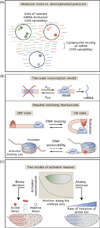The embryo as a laboratory: quantifying transcription in Drosophila
- PMID: 25005921
- PMCID: PMC4129518
- DOI: 10.1016/j.tig.2014.06.002
The embryo as a laboratory: quantifying transcription in Drosophila
Abstract
Transcriptional regulation of gene expression is fundamental to most cellular processes, including determination of cellular fates. Quantitative studies of transcription in cultured cells have led to significant advances in identifying mechanisms underlying transcriptional control. Recent progress allowed implementation of these same quantitative methods in multicellular organisms to ask how transcriptional regulation unfolds both in vivo and at the single molecule level in the context of embryonic development. Here we review some of these advances in early Drosophila development, which bring the embryo on par with its single celled counterparts. In particular, we discuss progress in methods to measure mRNA and protein distributions in fixed and living embryos, and we highlight some initial applications that lead to fundamental new insights about molecular transcription processes. We end with an outlook on how to further exploit the unique advantages that come with investigating transcriptional control in the multicellular context of development.
Keywords: embryogenesis; gene regulatory networks; live imaging; quantitative biology; single molecule FISH.
Copyright © 2014 Elsevier Ltd. All rights reserved.
Figures



References
-
- Crauk O, Dostatni N. Bicoid determines sharp and precise target gene expression in the Drosophila embryo. Curr Biol. 2005;15(21):1888–1898. - PubMed
Publication types
MeSH terms
Substances
Grants and funding
LinkOut - more resources
Full Text Sources
Other Literature Sources
Molecular Biology Databases

